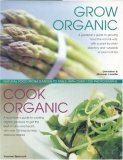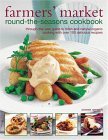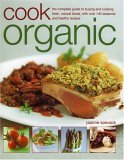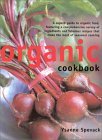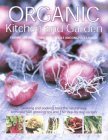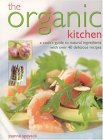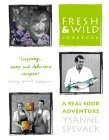Michael van Straten interview
by Ysanne Spevack
I’ve known Michael van Straten since I was a kid. He helped me through primary school, then through my adolescence. He was my friend throughout this formative time, and was definitely a major influence on me choosing to join the organic food and natural health revolution. But Michael had never met me until a couple of years ago. He had provided all of this information and inspiration to me and millions of other people by talking to us over the airwaves.
Michael van Straten has presented Bodytalk on London’s LBC Radio for 25 years. His fantastic hands-on knowledge of naturopathy, osteopathy, homeopathy, acupuncture and complimentary medicine has made Bodytalk Britain’s longest running and most listened to natural health program. Michael advised thousands of callers over the years about a huge range of natural health issues. He’s everybody’s alternative GP, teacher, healer and friend.
Michael’s popularity is down to his knowledge, approachability and genuine passion to help people heal themselves. He began studying orthodox medicine in the late 1950’s and went on to study osteopathy in the 1960’s. On completing his studies, Michael founded the Van Straten Clinic in his home village, Cheddington. He still has a practice there, where the grandchildren of some of his original patients are treated alongside patients from far and wide. He has written numerous books about natural health and continues to broadcast on LBC and other radio stations throughout Britain.
It all began in the way that it usually begins with the world’s best healers: as a child, Michael was very sick.
I spent the first ten years of my life in hospital. I had terrible ear infections, which actually turned out in the end to be an infection of the bones of my skull. They removed big chunks of my skull and didn’t think that I’d live, but I fooled them! I survived and have never been ill since.
“I wanted to be a doctor; always, since my earliest memories.” This childhood dream stayed with him throughout his school years and when Michael completed his A-levels he went to medical school. During a break in his studies, Michael worked at Stoke Mandeville Hospital, his local hospital and a world leader in the field of spinal injuries.
The first time I worked there was on the general side of the hospital. It was awful. Even then, in the late fifties, medicine was becoming a ‘pill for every ill’ type of practice. Patents were symptoms, not people. And I thought to myself, I can’t do this, dishing out pills for the rest of my life. I was very disillusioned and very dissatisfied.
Quite by chance I met an old school friend. He was an osteopath and I was fascinated. I decided to go to the college where he was studying. I studied osteopathy for two years and, wonderful as it is, I found that it wasn’t enough for me. Then I transferred to the British College of Naturopathy and Osteopathy and I started to get really interested in all the other aspects of natural medicine: fasting, nutrition, herbs, water treatments, relaxation treatments, psychology of health and all that sort of thing. And that’s when I first got involved in the organic movement, in about 1959.
For three years I didn’t dare tell my parents that I wasn’t going to be ‘their son, the doctor’. I didn’t get any grants and I had to work in the night. For four years I hardly went to bed. I was really very lucky, because my job was driving an emergency x-ray unit, so in four years I saw more emergency surgery and more casualty departments than most doctors see in a lifetime.
In those days people thought that I was a real lunatic for being involved with natural medicine. And then when I did acupuncture as well, people expected me to have a grass skirt and a bone through my nose! It was a long time ago and attitudes were very, very different.
Michael qualified in 1964, and started his practice. One of the many treatments he recommended for his patients was to take a Swiss health tonic called Biostrath. Within a couple of years, he had started a company to import, distribute and market it. By the time he was 26, Biostrath accounted for a mammoth 10% of the entire UK natural products market.
I started up the business and it was unbelievably successful. Biostrath was totally organic and was an extremely effective product; of course, it still is. By the late 1960’s we were turning over 1.5 million pounds per year, which was a lot of money in those days. I could afford to charter a plane and take fifteen health food retailers to Zurich for the weekend to look around the laboratories. In those days, most health food stores were owned by individuals who were absolutely dedicated to what they were doing. They’d come to be running their stores through personal experiences. They met the founder, called Pestallizzi and his friend Hugo Brandenberger who founded the company called Biotta which make juices. These were the pioneers of organic and biodynamic farming. And these UK health food shop retailers saw what could be done with organic foods, that it wasn’t all just ‘pie in the sky’.
One of the most influential things in my life was meeting Barbara Cartland. I saw an article by her in 1964. She wrote that her husband had recently died and about how awful it was being widowed. She wrote about how she was very depressed and was finding it very difficult to get back to normal living. Biostrath has very specific psycho-physical effect, so it’s very good for people with depression. I wrote her a note to say that I was very sorry to hear about it and sent her a couple of bottles of Biostrath.
I’d always admired her. A lot of younger people don’t know this, but she was one of the great pioneers of the health movement. She started the whole thing. She was the first person in the public eye who talked about organic food and the junk that our kids were eating. This was in the early 1960’s. She was the first person to say that people needed extra vitamins because the food industry was taking so much of the goodness out of our food. She was really the queen bee of the natural health movement. Everybody’s forgotten that now and just thinks that she’s a silly old bat. But she’s not, she’s a very bright woman.
A month later she phoned me and invited me to come to lunch. I was newly qualified and turned up in my ex-hire car that I’d bought from one of my dodgier patients in the back of an arch in Fulham. I parked beside her Rolls Royce and the three others outside her mansion and she was delightful. We became very good friends. It was fantastic. I went to dinners there and sat between the Duchess of Argyll and Mrs Ghandi. She’s an amazing woman.
Then I opened a shop in Marylebone in 1967 with Barbara Cartland. It was a completely organic health food shop. We sold all organic fruit and organic vegetables and we found an organic butcher who made organic sausages for us. It was just a bit before its time and just not quite in the right place, so it was a disaster and we lost a fortune. Which was a shame.
One time she called me up and said that she’d been asked to do a radio programme about vitamins and food additives. This was in the 1960’s and she said that she knew that there were going to be five professors there to slag her off. She had told the presenter that she would only do it if I could come too. A week after the programme, I got a call from a woman who asked me to come and do a phone-in for Radio Oxford. So I went and did the programme, which became once a month. Then late one night I was called by the presenter, who was now at LBC. Her guest had just phoned to say that he couldn’t make it. She wanted me to be there in half an hour! That then became a regular monthly, then fortnightly, then weekly slot. In those days, the medical attitude to anything alternative was vitriolic, and LBC regularly used to get calls and letters from doctors complaining that somebody like me was on air. However, after about a year, the director of LBC invited me to do my own programme. It was Bodytalk then and it’s still Bodytalk 25 years later.
Everybody wants to be on the telly and they ignore the radio. But radio has this intimacy and enormous ability to communicate. There’s nothing between you and the audience. It’s just words; there are no distracting pictures, no images, no tricksy camera angles. It’s much more real.
The Biostrath business, health food store, book writing, journalism and broadcasting has all gone on at the same time as Michael’s practice at Cheddington. The clinic has been running now for about 35 years.
I suppose my practice is the most important thing for me. The other stuff, the broadcasting and whatever, it’s great fun and I love doing it. If I spend an hour in my surgery I speak to one person, whereas when I spend an hour on the radio I speak to half a million people. But my practice has always been the most important thing. My practice is just like a GP’s medical practice, but in complimentary medicine. People come to me with everything.
There is always something that people can do to help themselves. That’s the great thing about naturopathy. It is much more of a teaching exercise than a therapeutic exercise. You teach people how to take better care of their health. That’s what makes it exciting. I’m now seeing the grandchildren of people that I originally saw in the sixties. So you know the whole family history, you know whether the father had some hereditary health problem or the brother was an alcoholic, all those sort of things. Just like old-fashioned medicine.
Michael has just had a fantastic new book published called Superherbs. It’s his sixteenth book and the third in a series of beautifully made, brightly coloured soft back books published by Mitchell Beazley. Superherbs joins Superjuice and Super Organic Foods and a fourth book in this series called Superboosters is due out in October.
The first book I wrote was called Bodytalk and it was based on the radio programme. It was all about the most popular problems and things that people called about. That was the beginning of my writing. Then I did the series of Superfoods books with Barbara Griggs for Dorling Kindersley publishers. They were hugely successful, with a very simple format and very informative. I’ve never been a lover of over illustrated, complicated books. Then a couple of years ago I was approached by Mitchell Beazley publishers to do a series of smaller books. The first one was Superjuice. As a naturopath, juicing has always been very much a part of the therapy that I’ve advised and used myself.
Superjuice contains over a hundred different recipes for health-promoting and delicious fresh juices, smoothies, shakes and cocktails.
There are also reference tables at the back of the book for ingredients and vitamins and minerals. There is also a guide to different illnesses and ailments, explaining which juices are best to make you better.
After Superjuice came Super Organic Foods, which is all about organic foods and the reasons for it. The book particularly focuses on the reasons not just for your personal health, but for environmental reasons. If you look at crops like tobacco, cotton, coffee, tea, these are the most heavily sprayed and toxically damaged crops in the world. Yet those toxins don’t directly bother us as consumers, because we don’t get them. It’s the actual workers in the fields that suffer. It’s a nightmare, it’s just morally reprehensible that we should allow that to go. All this fuss about the Zimbabwean farmers — I don’t give a stuff about them. 10% of the population of Zimbabwe own 90% of the land and it’s mostly tobacco farms. They couldn’t care less about the living conditions of their workers. They’ve had all sorts of genetic problems, conception problems, fertility problems, skin problems, high cancer incidences. This is why Super Organic Foods talks about the environmental reasons for going organic.
Super Organic Foods is a comprehensive and easy to use guide to all the key issues surrounding organic foods. It provides a detailed critique of the reasons why genetically modified foods are so bad for us and the planet. Super Organic Foods also contains an at-a-glance table of raw ingredients, with organic foods directly compared with the agrochemical equivalent in terms of nutrition and chemical residues. There are top tips for mother and baby and lots of fantastic recipes including my personal favourite, ‘World’s Easiest Wholemeal Bread’.
The next book in the series is Superherbs, it is full of information about how to use therapeutic herbs for health and healing. It starts with a history of herbs around the world. There’s a cornucopia of herby recipes, from aphrodisiacs to brain power potions. Also there’s a comprehensive guide to growing and harvesting your own and an easy to use index of healing herbs for different ailments. All 65 of the recipes are accompanied by clear and detailed explanations of how the herbs in each dish work. So the recipe for Passionate Poisson on page 69 reveals that the coriander in the dish produces an aphrodisiac effect from its complex combination of volatile oils, flavonoids and phenolic acids. And the saffron helps menstrual problems as well as acting as an aphrodisiac.
I’ve always been interested in herbs, because their healing powers are extraordinary, amazing. A lot of people don’t realise that culinary herbs are used for health reasons as much as for taste. You put sage with roast pork because sage helps to break down the fats. You put mint with lamb for the same reason. Mint oil is probably the most effective antacid of all time and is listed in the British Pharmacopoeia as a prescribable medicine. I thought it would be really nice to do a book that showed the relationship between flavour and herbs and health and that healthy eating is not something miserable. The recipes in the book are delicious! And if I can cook it, anyone can cook it!
People are often very surprised when they look at these recipes, and wonder if it’s really good for their health as well as being delicious. They find it very hard to believe that you don’t have to have your herb as part of some horrible tincture, or boil it up in a saucepan, or take a pill. You can just grow it in a pot on your windowsill and put it in your food — and it does you good! I enjoyed writing about that — it was fun.
There is another book in the pipeline called Superboosters. This book will be published in October and will be a detailed guide to the top fifty natural superboosters. It will include favourites like St John’s Wort, Echinacea, evening primrose oil and royal jelly. As well as a detailed analysis of how they work, there will be lots of information about where each superbooster comes from, a breakdown of active constituents and who they are particularly good for.
Michael van Straten has recently married the deputy editor of Woman magazine, Sally Pierce. He had worked with Sally for many years. He is Alternative Health Editor for Woman and has written for Chat, Best, OK and Woman over the past 10 years, as well as the Daily Mail, Sunday Times and the Express. Michael is very much a man of the people, preferring to write for mass market magazines and newspapers rather than highbrow publications.
Sally and I both love gardening. We’re just about to start building a new big herb garden. We have a very big vegetable garden and we had chickens until the fox ate them all! That’s the trouble when you let them wander about — ours were able to go everywhere. We have lots of geese and moorhens as well as the cats.
The day before I visited Michael, he had been in Gloucestershire giving a talk to some of the senior executives from Kraft foods about the benefits to their company, their consumers and the planet of launching an organic range of foods.
If you wanted to think of a company that produced rubbish food, Kraft would probably be near the top of your list. It’s a huge company owned by Philip Morris, the tobacco multinational. Lots of the big tobacco companies are branching out and diversifying, mostly into food. Kraft own Kenco coffee, Jacobs cream crackers, and lots of other brands. But interestingly, they are about to launch an organic coffee. I was approached by them to talk to some of their senior staff at an organic farm in Gloucestershire. They responded very positively and said it was very thought provoking.
I gave them a sheet of paper with a list of food additives on it, with their known or suspected side effects. I asked them if they’d give that to their kids. I then had a go at them about their labelling, about the fact that they don’t use terms that are easily understandable. They asked me what two things I would do if I could run Kraft foods. Surprisingly, I wouldn’t junk Dairylea because it’s their core product. What I would do is introduce a ‘healthy option’ Dairylea. The second thing that I would do is change all the labelling to be on the front of the packet. In large letters I’d put how much fat, how much saturated fat, how much sugar, how much salt in this portion. Then it would have a code underneath to say if it is high in salt, low in fat, or whatever so that people know. They’re afraid of doing this because it flies in the face of all the psychobabble marketing-speak, but people want the truth.
It’s not true that 99% of people interested in organic foods are posh or middle class. I get a thousand letters every week, nearly all of them on scraps of old envelopes or pieces of paper torn out of a notepad. They don’t come on crested notepaper, or double laid Conqueror with embossed addresses on the top. These are C2, D and E people, ordinary people. They are the people that are really worrying about this stuff. If you go to your health food store, the people shopping there are ordinary people.
I think that it’s tremendous that companies like Kraft foods want somebody like me to talk to them. It shows that they realise what their failings are. They have a moral responsibility, not just to their shareholders, but to the planet we live on and to the people who have to produce the raw ingredients that they use. Most of all, they have a moral responsibility towards their consumers. If it’s within their power to make changes that will benefit the health of their consumers, they must do it. Companies of that size have the clout to do it. They have the marketing clout, the manufacturing expertise, the production facilities, the technical knowledge; they could do it tomorrow! Historically, Dairylea was a result of the war, it was never meant to be a staple food for kids full of saturated fats and trans fats. It was meant to be good for people after the shortages of the war, to give people calcium. But times have changed and they haven’t moved with it. The excuse that they’re too big to make those changes is not good enough. If they don’t go organic, they’ll get left behind and they’ll vanish just like Heinz Sandwich Spread.
When I asked Michael to tell me the thing that he is most proud of doing, he went shy. He didn’t want to sound pompous and he’s obviously not very fond of blowing his own trumpet. However, when I insisted that there must be something, he responded that the thing that gives him most pleasure is seeing people flourishing who he had urged to go into the natural health profession.
I see them doing good things and spreading the word. One’s in New Zealand, one’s in Spain, there are two in the USA, there are others all over the UK. There’s a young man who’s just completed his first year at the college who I influenced enough to make him actually do it. That’s the most important thing that I think I’ve done. That’s what’s passing on the heritage. Alternative medicine is an apprenticeship profession. It’s an oral tradition, it’s the tradition of the shaman. Our students now get BSc Honours degrees and have lots of academic background. But it’s not until they are in a clinic with their tutor and with a patient and that tutor is passing on knowledge orally that they start to actually become practitioners. Until then they’re students or scientists.
If you speak to any doctor who’s honest, they’ll say that a lot of what they do is intuitive. You can’t subject every patient to every test to find out what’s wrong with them. You get an intuitive feeling about the patient. You use the scientific knowledge, but it’s your intuitive feelings about people that leads you to a diagnosis. Whether it’s orthodox or complimentary medicine, it is much more art than science, even now. The science is in the application of what you do, in the verification of what you think is wrong with the patient. Science is not the heart of medicine. The heart of medicine is the art of healing. And that’s the traditions of shamanism.
I spent some time in the Amazon rainforest in Brazil with the indigenous people. The tragedy there is that the young people for the last two or three decades have seen the twinkling lights of the cities. As the old medicine men die off, there is nobody left for them to pass the tradition on to. Unless they pass that tradition on, every time one of them dies it’s like burning down a library. Their knowledge dies with them. Luckily with naturopathy, a lot of that tradition does continue. I think that is desperately important and I hope that the youngsters who I’ve influenced will then go on and influence the next generation of youngsters.
My philosophy is go with the flow. What happens, happens. I think that if you set goals and targets, you become so focused that you miss the periphery. The really exciting thing might be just over there, but if you have tunnel vision you miss it. I have no inclination to retire!
I think it would be wonderful if all the complimentary therapies were available on the NHS, although the bureaucracy would be a nightmare. We’d spend all our day filling out forms and doing critical path analyses and self assessments. All that paperwork is totally foreign to the nature of most practitioners within the complimentary field, because you have to be a rebel. You need to be rebellious, you need to question the establishment, you need to rattle the cage and not be complacent. It’s been the compliant and complacent population that’s let agribusiness do the terrible things to our world that its done. If more people had made a fuss and stopped buying the stuff forty years ago, we wouldn’t be in this mess.
I was hugely influenced by meeting Schumacher and Rachel Carson. She wrote ‘Silent Spring’, which was the first book that drew people’s attention to the fact that in the US the birds weren’t there any more. There was no spring song, because the chemicals had got into the food chain and the birds had died. Schumacher was an economist who used to work for the Coal Board when we had a UK coal industry. After running this vast organisation, he had a complete change of heart. He realised that it was all wrong and that the economies of scale was a dreadful mistake. He wrote a marvellous book called ‘Small is Beautiful’, about how down-sizing businesses is the only salvation for the planet.
Schumacher argued that the only way forward for the planet was for businesses to be small and locally based. That way, towns and villages could return to the near self-sufficiency they enjoyed before the war. Commodities like prepared foods and fresh produce would all be seasonal and local and therefore more nutritious. Food has its highest nutrient content when it’s ripe and ready to eat. Un-ecological food miles would be eradicated, saving the planet from transport pollution.
If large companies break themselves down into smaller units, but maintain benefits like central accounting and marketing, then they get the best of both worlds.
That sounds like another wise, realistic and intelligent idea from the man that is a friend and mentor to so many people. I look forward to seeing the corporations taking his advice, for all of our futures. I thoroughly recommend everyone interested in organic food, natural health and healthy eating to read Michael’s books!
Superherbs, Super Organic Foods and Superjuice are all published by Mitchell Beazley and are £10.99 each. For details, call 01933 443863
Superfoods, Superdietfoods and Superfastfoods are all co-written with Barbara Grigson for Dorling Kindersley. For details, call 020 7836 5411
Like this page? Please link to us and let the world know!



